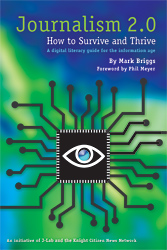I’ve grown accustomed to answering questions about the future of journalism, the life expectancy of printed newspapers and the financial prospects of online journalism. I have my opinions, of course. But the skepticism I’m used to hearing from journalists in the U.S. pales in comparison to some of the comments heard at a panel discussion I took part in last night in Dubai.
And with good reason.
Turns out, the Gulf Region still likes their print. In fact, arguably the region’s best newspaper launched just three years ago. In the U.S. we have the Huffington Post overtaking the Washington Post in online audience, but in the UAE it’s the upstart National shaking up the region – in print.
There are a number of English-language newspapers here, all printed in full broadsheet and full color (yes, on every page!) They are full of ads, too. Online media has a role for the traditional media companies, but it’s limited, compared to the U.S. and other cities in the West. And social media, especially Twitter, have been slow to gain critical mass. (Although apparently Facebook is doing quite well.)
Still, the future of journalism in the Middle East was apparent from the panelists assembled, and were representative of panel discussions I often do in the States. Pia Heikkila represented “big brand media.” As a freelancer, she sells her work to the BBC, Guardian and Al Jazeera (where she used to work). She flew in from Kabul where she is currently doing an assignment as a one-woman video journalist (5 months pregnant, to boot).
“Digital journalism is in its infancy, but has unlimited of potential. If the old dinosaurs don’t embrace the new world, they will die. The new world is already here. We need to change the way we think,†Heikkila said.
Also on the panel were a couple of new media success stories from the Gulf region. Ali Al Saloom is a self-described and well-known “brand” for his Ask Ali column in newspapers and corresponding website. He has also published a book and produces videos.
“Print is king,” Saloom said. “I know the cultures are different in the UK and in America, but print is still king here.”
Nabila Usman disagreed. Usman is a reporter/writer/blogger for Newzglobe.com, which just launched in the UAE and is already seeing impressive traffic. She described the content as “quirky” and “edgy” and apparently stirred up quite a controversy recently when she tried to attend a media forum at a bar while wearing her hajib (which is not allowed under UAE law). She and a few others were turned away, which she reported, and caused quite an uproar judging from the comments.
Usman predicted print newspapers going away in the next 10 years and envisioned taking her children to see copies of them in a museum. (Nice touch.)
While I’m confident that newspapers will still be available in print in the Gulf in 10 years, I’m also confident that online news will command a much bigger piece of the audience – and revenue – than today. The region might be a few years behind the U.S. in terms of technology and startup news projects, but this is a place that knows how to bigger/faster/better as well as anywhere. I won’t be surprised if we, in the U.S., are looking to the UAE for online news innovation by 2020.

 Mark Briggs
Mark Briggs  Posted in
Posted in  Tags:
Tags: 




